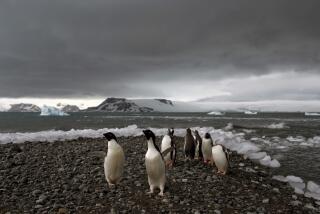South Pole Sojourn Was Stellar Success for UCI Astrophysicist
- Share via
It took a few days for Steve Barwick to get used to the high altitude, the 24-hour-a-day sunshine and temperatures hovering around minus 25 degrees Fahrenheit at the South Pole U.S. research station.
Once he did, though, the UC Irvine astrophysicist plunged into the arduous work of burying sophisticated photographic equipment deep in the Antarctic ice pack in hopes of exploring the cosmos by means of high-energy neutrinos, elusive particles emitted by distant stars.
What began as a trial mission last December to see whether such a “neutrino telescope” actually would work was so successful that Barwick and fellow researchers already plan to go back next year to install the real thing.
“We didn’t think it was going to be this good,” said the 32-year-old assistant professor. “In spite of all the mechanical problems, things worked marvelously well.”
“Things worked out so well that we are going to be more ambitious than we were before,” added Francis Halzen, a theoretical physicist at the University of Wisconsin at Madison who has worked on the project for the past five years with colleagues at UCI and UC Berkeley.
If the National Science Foundation agrees to fund the proposed $2.5-million project, Barwick and his colleagues hope in three years to have nine strands of fiber optic cables and photomultiplier tubes each buried more than half a mile deep across 10,000 meters of ice. If they succeed, the Antarctic Muon and Neutrino Detector Array--aka AMANDA--would be the world’s largest neutrino detector. Eventually, they hope to have 10 times that number across half a mile of the polar region on continuous neutrino watch.
For decades, physicists have been trying to capture evidence of these ghost-like particles, which can pass through entire planets, even galaxies, at near the speed of light without striking anything. But only a relative few have been spotted by existing detectors in mine shafts and mountain caverns around the world.
The reason, Barwick and fellow astrophysicists from UC Berkeley and the University of Wisconsin at Madison believe, is that existing detectors aren’t big enough. An array the size planned for AMANDA, and pointed toward the earth’s core to screen out cosmic rays from our atmosphere, would be more likely to net results.
“We’re looking for that one neutrino coming up per year,” Barwick said.
The neutrinos Barwick and his colleagues seek are believed to be produced in nuclear reactions within neutron stars, pulsars, quasars and black holes. The tiny particles then spin beyond the massive gravitational field of these stars at close to the speed of light. By calculating a neutrino’s path back to its origins, astrophysicists say they will be able to peer into the inner workings of these mysterious stellar objects and learn more about the forces that created our universe.
Until this winter, however, AMANDA had been just theory. No one was really sure that the polar ice would be clear enough, whether they could drill deep enough, or whether the specially tempered glass orbs housing the photographic equipment would be able to withstand the pressure of ice water refreezing around them. Nor did they know whether they would detect background radiation that clouds the results.
It took 16 days for the Antarctic team of drillers to sink the first hole on Jan. 5, in part because the drill sensor equipment couldn’t accurately measure the exact diameter of the hole along the entire depth, Barwick said. The team got better, though. The second was done in six days.
In each case, a strand of photomultiplier tubes was lowered into the hole and water froze quickly around it. Barwick and fellow researchers raced to their computers at a nearby hut to check for results.
“We found out that all of our modules survived the water freezing back, and that’s very encouraging,” Barwick said. “And not only was the ice clear, there was no radiation. . . .
“Now we know we have a technology that’s very inexpensive, very sturdy. It survived the trip down there and survived the water refreezing. . . . So we think we have a good case for putting more sensors down.”
In fact, once-skeptical colleagues who have heard their results at recent gatherings of physicists now want to know the fine details of the project, he said.
No neutrinos have been detected with the prototype strands, which are still in operation. But that was never the plan for the first trip. When the real AMANDA arrays go in over the next three years, the strands--each bearing 19 sensors--will be strategically placed to ensure the greatest odds for detecting telltale evidence of neutrinos.
Conditions at the South Pole are unusual: constant daylight and little to do but work.
“The sun never drops below the horizon,” Barwick said. “For the first few days, it’s a bit unnerving. You’re normally used to working until, say, 10 at night. But no matter how sleepy you were, once you went outside in the light, all of a sudden you were wide awake.”
As for the weather, being out in minus 10 to minus 25 degrees Fahrenheit wasn’t so bad. “If there’s no wind, the parkas and the boots they give you are plenty warm,” Barwick said.
The most memorable event was New Year’s Eve, which was heralded with a feast on tablecloths and a rock band assembled from the research station crew.
And since you can be in any time zone you choose when you’re at the South Pole, he said some personnel celebrated for 24 hours straight.
Although he missed the entire holiday season with his wife and small daughter, Barwick is eager to return next year.
“It was a lot of fun,” he said.






